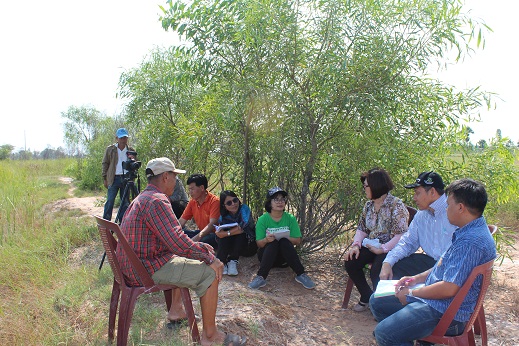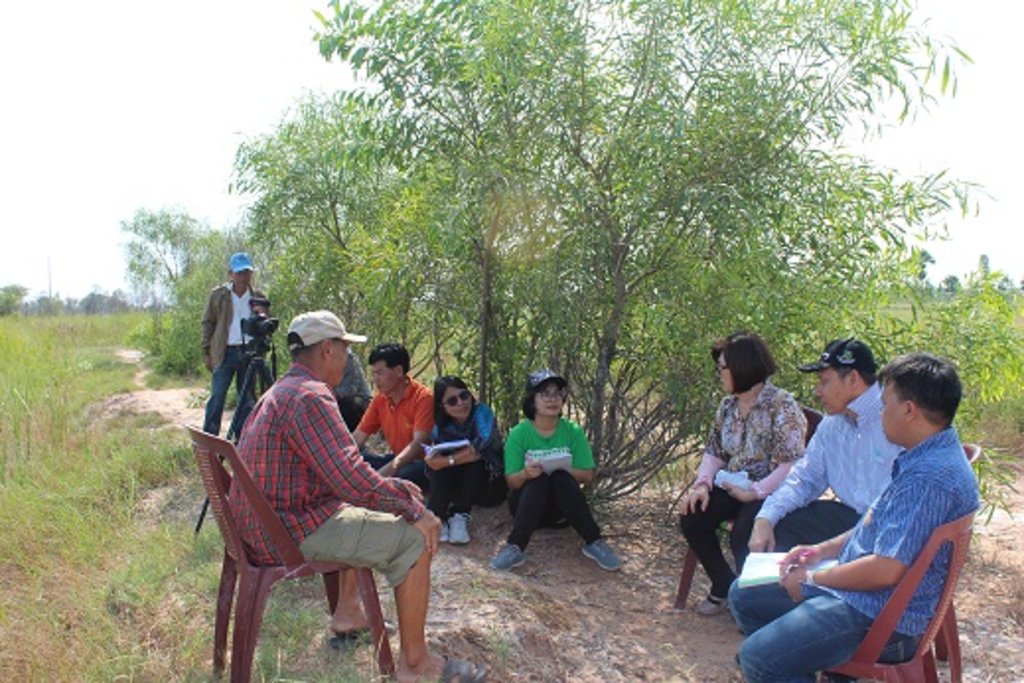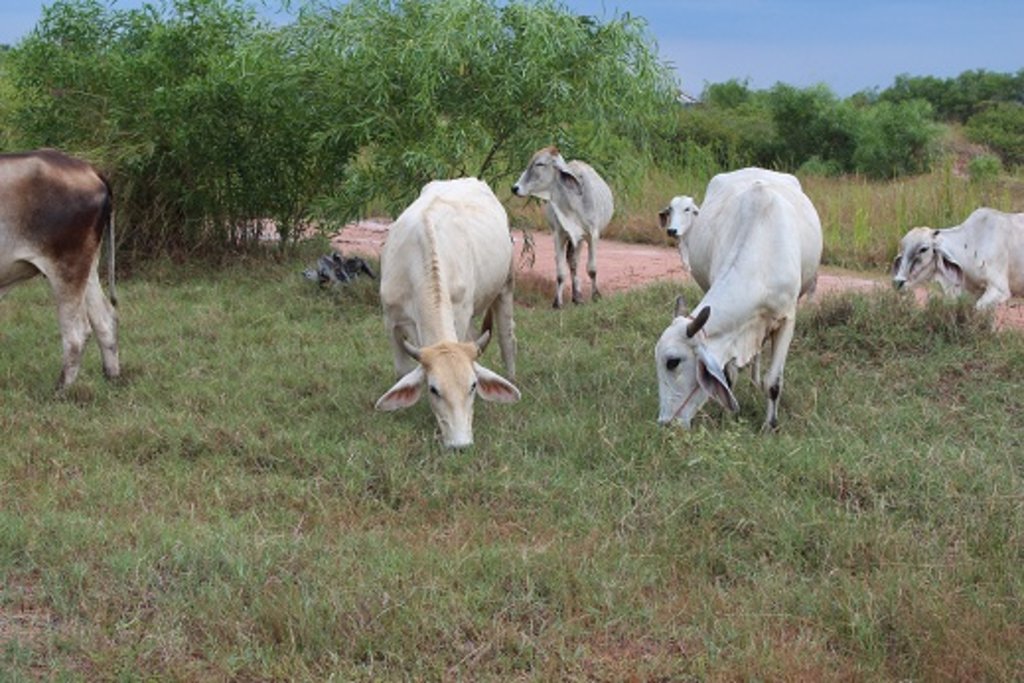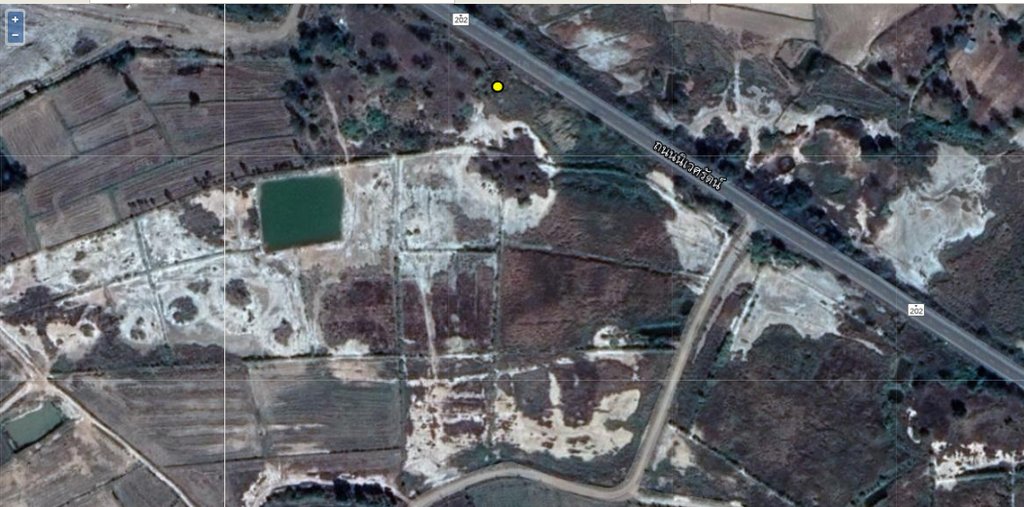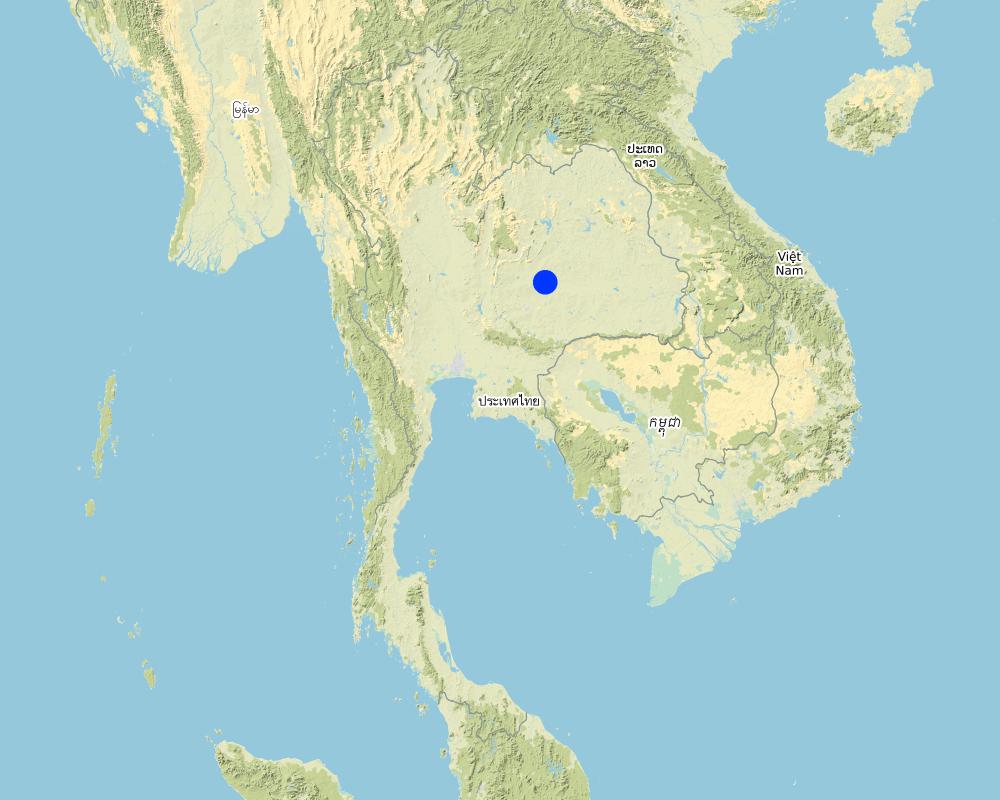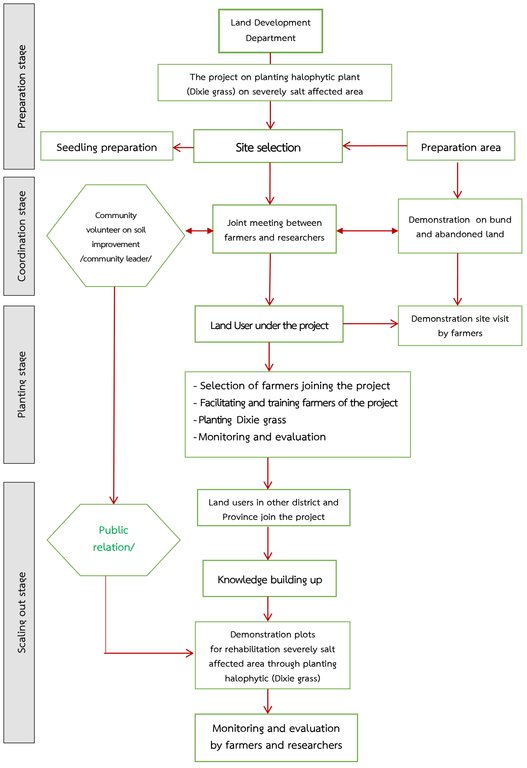Vegetative approach of using a halophyte ("Dixie grass", Sporobolus virginicus)) to rehabilitate severely salt-affected land. [Таиланд]
- Создание:
- Обновить:
- Составитель: Kamontip Sasithorn
- Редактор: –
- Рецензенты: Rima Mekdaschi Studer, Samran Sombatpanit, William Critchley
approaches_4210 - Таиланд
Просмотреть разделы
Развернуть все Свернуть все1. Общая информация
1.2 Контактные данные специалистов и организаций, участвующих в описании и оценке Подхода
Ответственный (-ые) специалист (-ы)
землепользователь:
Yooburi Somsak
+66-80-7240599
10 Moo 12, Ban Kut Chok, Kut Chok Sub-district, Buayai District, Nakhon Ratchasima Province 30120
Таиланд
землепользователь:
Sriwootpong Rungariam
+66-93-4613289
107 Ban Donpae Moo 8, Kut Chok Sub-district, Buayai District, Nakhon Ratchasima Province
Таиланд
Department of Agricultural Extension officer:
Auonpokang Chiwat
+66-85-7783258
Buayai District Agricultural Extension Office
49 Buayai Sub-district, Buayai District, Nakhon Ratchasima Province 30120
Таиланд
землепользователь:
Kumtisong Noorian
+66-62-1524591
45 Moo 10, Dang-chang Sub-district, Buayai District, Nakhon Ratchasima Province 30120
Таиланд
Специалист по УЗП:
Специалист по УЗП:
Специалист по УЗП:
Специалист по УЗП:
National consultant:
Название проекта, содействовавшего документированию/оценке Подхода (если применимо)
Book project: where the land is greener - Case Studies and Analysis of Soil and Water Conservation Initiatives Worldwide (where the land is greener)Название проекта, содействовавшего документированию/оценке Подхода (если применимо)
Book project: where the land is greener - Case Studies and Analysis of Soil and Water Conservation Initiatives Worldwide (where the land is greener)Название организации (-ий), содействовавших документированию/оценке Подхода (если применимо)
Land Development Department LDD (Land Development Department LDD) - Таиланд1.3 Условия, регламентирующие использование собранных ВОКАТ данных
Когда были собраны данные (на местах)?
18/10/2018
Составитель и ответственный/-ые специалист(-ы) согласны с условиями, регламентирующими использование собранных ВОКАТ данных:
Да
1.4 Ссылка (-и) на Анкету (-ы) по Технологиям УЗП
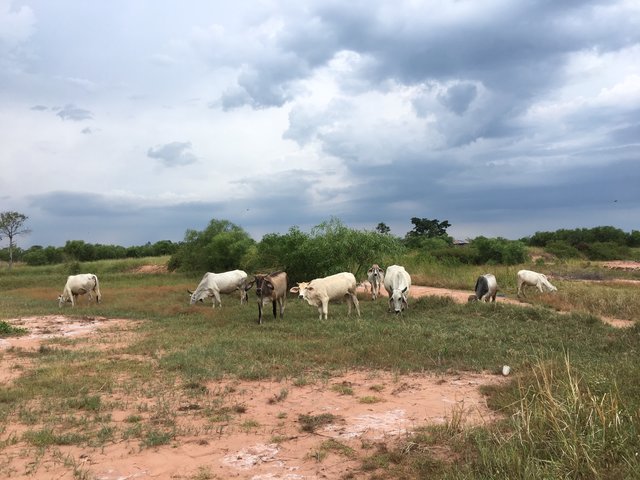
Planting a Halophyte (Sporobolus virginicus, "Dixie grass") to … [Таиланд]
Planting a halophyte - Dixie grass (Sporobolus verginicus) - aims to increase the area of land usable by farmers and to prevent expansion of severely saline soils. Dixie grass can be utilised as cattle feed. The Land Development Department has been involved in developing and disseminating this technology.
- Составитель: Kamontip Sasithorn
2. Описание Подхода УЗП
2.1 Краткое описание Подхода
The government promotes a halophyte (Dixie grass) to control severely salt-affected land, rehabilitate the ecosystem and prevent the spread of salt in soil - with the cooperation of land owners, livestock farmers, the local administration, the local government agency, Land Development Department researchers and with specialists/ technical advisors in various fields.
2.2 Подробное описание Подхода
Подробное описание Подхода:
The Ministry of Agriculture and Cooperatives through its Land Development Department (LDD) initiated a project on planting salt-tolerant trees and grasses on severely salt-affected land in the Northeast of Thailand in 1996. The project has facilitated the planting of a halophyte (a salt-loving plant), namely Sporobulus virginicus (Dixie grass) on salt-crusted and barren land. The main objectives of the approach has been to encourage land users to maximize their land area for farming, by preventing the formation of extensive severely saline soil. This is through planting Dixie grass as a cover crop to rehabilitate the land and ecosystem. The activities started with public meetings, then identifying severely salt-affected areas, and setting-up demonstration plots on farmers’ land to act as learning centers. There has also been communication with the local administration to call farmers’ meetings to develop detailed work plans and discuss strengths, weaknesses, opportunities, and threats of planting Dixie grass. The implementing activities consisted of 4 stages; PREPARATION was for seedling preparation, site selection of severely salt-affected soil and land preparation, public meetings and the establishment of the demonstration plot at Dan Chang Sub-district, Buayai District, Nakhon Ratchasima Province. COORDINATION included a joint meeting between farmers and researchers, joint monitoring & evaluation and follow-up and land users' decision-making. PLANTING started with selection of farmers joining the project, facilitating and training, a site visit to the model demonstration plot: this plot is the model for planting salt-tolerant trees and grasses on severely salt-affected land in the Northeast of Thailand. The final activity of SCALING-OUT occured when the land users/ farmers found that after 3 years of planting Dixie grass this barren land became covered by plants and much improved in biodiversity by the evidence of many varieties of wild grasses, flowers, dragonflies, small mammals and birds. Farmers could now grow rice and they used Dixie grass as feed for livestock. Moreover, and attractively, farmers were able to increase their incomes. Migration to big cities was reduced. The stakeholders were land owners, livestock farmers, the local administration, the local government agency, researchers and SLM specialists from LDD - and all worked together to mutual benefit. Nevertheless, although planting halophytes improves severely saline soil with low input costs, the recovery/accomplishment time (in saline soil improvement) cannot be as fast as that of engineering measures with much higher investment.
2.3 Фотографии, иллюстрирующие Подход
2.4 Видеоматериалы по применению Подхода
Дата:
18/10/2018
Место:
6 Ban Donpae Moo 8, Kut Chok Sub-district, Buayai District, Nakhon Ratchasima Province
2.5 Страна/ регион/ место, где применялся Подход
Страна:
Таиланд
Административная единица (Район/Область):
Nakhon Ratchasima Province
Более точная привязка места:
6 Ban Donpae Moo 8, Kut Chok Sub-district, Buayai District
Map
×2.6 Даты начала и окончания реализации Подхода
Год начала реализации:
2015
Год окончания (Если Подход больше не применяется):
2016
2.7 Тип Подхода
- в рамках проекта/ программы
2.8 Каковы цели/ задачи Подхода
The main objective of the approach was to enable and encourage land users to maximize land for farming, through preventing the formation of extensive severely saline soil, by the use of the halophyte, Dixie grass, as a cover crop.
2.9 Условия содействующие применению Технологии/ Технологий в рамках Подхода или затрудняющие его
Социальные/ культурные/ религиозные нормы и ценности
- содействуют
The land users follow what their neighbours practice.
Наличие/ доступность финансовых ресурсов и услуг
- содействуют
Through the Bank for Agriculture and Agricultural Cooperatives.
Институциональные условия
- содействуют
Local administration
Сотрудничество/ координация действий
- содействуют
Coordination of soil doctor volunteers and community leaders in the area.
Программные документы/ руководящие установки
- содействуют
The government has a policy of preventing soil degradation.
Осведомленность в области УЗП, доступность технической поддержки
- содействуют
To provide knowledge to land users in the area.
Объем работ, доступность рабочей силы
- содействуют
For land users under the project
- затрудняют
For land users outside the project
3. Участие и распределение ролей заинтересованных сторон
3.1 Заинтересованные стороны, участвующие в реализации Подхода и их роли
- местные землепользователи/ местные сообщества
Farmers under the project
Planting halophytes (Sporobolus virginicus - Dixie grass)
- организации местных сообществ
Local administration (Sub-district Administration Organization)
Call for meeting
- эксперты по УЗП/ сельскому хозяйству
Land Development Department
Site selection
- ученые-исследователи
Land Development Department
Provide technical recommendations
- государственные власти (отвечающие за планирование или принятие решений)
Land Development Department
Funding, planner, decision-makers
3.2 Участие местных землепользователей/ местных сообществ на разных стадиях реализации Подхода
| Участие местных землепользователей/ местных сообществ | Перечислите участников и опишите их вовлеченность | |
|---|---|---|
| инициирование/ мотивация | интерактивное | Land users in the project based |
| планирование | пассивное | Discussion with land users on work plan before starting the activity. |
| выполнение | внешняя поддержка | Land users/farmers in the project |
| мониторинг/ оценка | внешняя поддержка | Land users in the project |
3.3 Схема реализации (если имеется)
Описание:
Four stages of participating process of technology development among organizations, community volunteers on soil improvement, farmers, SLM specialists and researchers.
Автор:
Kamontip Sasithorn
3.4 Принятие решений по выбору Технологии/ Технологий УЗП
Укажите, кто принимал решение по выбору применяемой Технологии/ Технологий:
- преимущественно специалисты по УЗП после консультаций с землепользователями
Поясните на чём было основано принятие решений:
- анализ подробно описанного опыта и знаний по УЗП (принятие решений на основе подтвержденных фактов)
4. Техническая поддержка, повышение компетенций и управление знаниями
4.1 Повышение компетенций/ обучение
Проводилось ли обучение землепользователей/ других заинтересованных лиц?
Да
Укажите, кто проходил обучение:
- землепользователи
Тип обучения:
- опытные участки
- общие собрания
Рассматриваемые темы:
Prevention and rehabilitation of salt-affected land with available technology and increased income for farmers.
4.2 Консультационные услуги
Есть ли у землепользователей возможность получать консультации?
Да
Укажите, где именно оказываются консультационные услуги:
- на полях землепользователей
Описание/ комментарий:
1. Soil doctor volunteers represent the Land Development Department with a duty to provide knowledge to farmers in the area.
2. SLM specialists from Land Development Department visited and advised farmers in the area.
4.3 Институциональная (организационная) поддержка
В ходе реализации Подхода были ли организованы новые институциональные структуры или поддержаны уже существующие?
- нет
4.4 Мониторинг и оценка
Являются ли мониторинг и оценка частью Подхода?
Да
Комментарии:
SLM specialists from Land Development Department collaborated with LDD soil doctor volunteers in surveying the survival rate and following up the growth of plants in the area.
Если да, будет ли данный документ использоваться для мониторинга и оценки?
Да
4.5 Научные исследования
Были ли научные исследования частью Подхода?
Да
Укажите темы исследований:
- технология
Напишите подробнее и назовите тех, кто выполнял исследования:
The Soil Salinity Research Group, LDD, conducted research on "halophytes plantation and the flow path along the landscape in Northeast Thailand" with Dr. J.L. Gallagher from Delaware Biotechnology Institute, University of Delaware.
5. Финансирование и внешняя материальная поддержка
5.1 Годовой бюджет мероприятий по УЗП в рамках Подхода
Если точный годовой бюжет неизвестен, укажите примерный диапазон затрат:
- < 2000
Комментарий (например, основные источники финансирования/ ключевые доноры):
Land Development Department
5.2 Финансирование и внешняя материальная поддержка, предоставляемая землепользователям
Предоставлялась ли землепользователям финансовая/ материальная поддержка для применения Технологии /Технологий?
Да
Если да, укажите тип(-ы) поддержки, кто ее предоставил и условия предоставления:
Dixie grass planting material and land preparation cost
5.3 Субсидии на отдельные затраты (включая оплату труда)
- труд
| В какой степени | Опишите субсидии подробнее |
|---|---|
| профинансированы полностью | Planting |
- другие
| Другой (какой именно) | В какой степени | Опишите субсидии подробнее |
|---|---|---|
| seeding | профинансированы полностью | free seedings |
Если труд землепользователя был существенным вкладом, укажите, был ли этот вклад:
- за денежное вознаграждение
Комментарии:
Due to the landowner having insufficient labor for grass planting, there is a need to hire workers at 175 THB/person/day (the minimum rate)
5.4 Кредитование
Предоставлялись ли в рамках Подхода кредиты на мероприятия УЗП?
Нет
5.5 Другие методы или инструменты стимулирования
Использовались ли другие методы или инструменты стимулирования для продвижения Технологий УЗП?
Нет
6. Анализ влияния и заключительные положения
6.1 Влияние Подхода
Сумел ли Подход расширить возможности местных землепользователей, повысить участие заинтересованных сторон?
- Нет
- Да, немного
- Да, умеренно
- Да, существенно
Generate food security and family income.
Сумел ли Подход дать возможность принимать решения на основе подтвержденных фактов?
- Нет
- Да, немного
- Да, умеренно
- Да, существенно
Establish learning center for farmers as an information for technology adoption.
Сумел ли Подход помочь землепользователям внедрить и поддерживать технологии УЗП?
- Нет
- Да, немного
- Да, умеренно
- Да, существенно
Farmers well adopted the technology, resulting in the expansion of such Approach to a wider area.
Сумел ли Подход расширить знания и возможности землепользователей в применении практик УЗП?
- Нет
- Да, немного
- Да, умеренно
- Да, существенно
Farmers have adapted and changed SLM model to suit their own preference.
Сумел ли Подход способствовать улучшению продовольственой безопасности/ качества питания?
- Нет
- Да, немного
- Да, умеренно
- Да, существенно
Farmers can grow rice and they use Dixie grass as feed for livestock.
Сумел ли Подход привести к созданию новых рабочих мест/ к расширению возможностей получения дохода?
- Нет
- Да, немного
- Да, умеренно
- Да, существенно
The migration for job to big cities has reduced.
6.2 Основные причины, побуждающие землепользователей внедрять УЗП
- рост продуктивности
From the interview, farmers were satisfied with this technology of Sporobolus virginicus planting to rehabilitate severely saline soil. Besides being lower in salination farmers got more rice yields and better environment and livelihoods.
- снижение деградации земель
After 3 years of planting Dixie grass, it was found that the formerly barren land became covered by plants and much improved in biodiversity by the evidence of many varieties of wild grass, dragonflies, small mammals and birds.
6.3 Долгосрочная устойчивость мероприятий в рамках Подхода
Могут ли землепользователи самостоятельно (без внешней поддержки) продолжать применение того, что было реализовано в рамках Подхода?
- да
Если да, опишите как:
Farmers have better understanding and positive attitude of planting halophytes (e.g. Dixie grass). Moreover, they have more income generated from rice yield and livestock, as farmers can now grow rice and used Dixie grass to raise livestock.
6.4 Сильные стороны/ преимущества Подхода
| Сильные стороны/ преимущества/ возможности по мнению землепользователей |
|---|
| Soil doctor volunteer, local government agency and community leader were the coordinators in the area. |
| Farmers had easy access to markets and sources of Dixie grass cuttings. |
| Distribution of Dixie grass cuttings was done at no cost. |
| Сильные стороны/ преимущества/ возможности по мнению составителя или других ключевых специалистов |
|---|
| A supported technique created to make better environment on severely saline soil in the Northeast of Thailand. |
| Technique in planting Dixie grass was provided continually by Land Development Department and community volunteers on soil improvement. |
| A demonstrated plot was established in the area. |
6.5 Слабые стороны/ недостатки Подхода и пути их преодоления
| Слабые стороны/ недостатки/ риски по мнению землепользователей | Возможные пути их преодоления/снижения? |
|---|---|
| Advertising of project was not extensive enough, particularly to the area of severely saline soil. | It is necessary for the Land Development Department to cooperate more closely with local administration to promote the project. |
| Слабые стороны/ недостатки/ риски по мнению составителя или ответственных специалистов | Возможные пути их преодоления/снижения? |
|---|---|
| Some farmers did not believe that Dixie grass was very salt tolerant and will make the salinity of the soil decrease after planting it. | The officers should build up knowledge from successful farmers by frequently visiting farmers in the area under the project "rehabilitation of severely salt-affected soil by planting Dixie grass". |
7. Справочные материалы и ссылки
7.1 Методы сбора/источники информации
- опросы землепользователей
- опросы специалистов/экспертов по УЗП
7.2 Ссылки на опубликованные материалы
Название, автор, год публикации, ISBN:
Land Development Department
Где опубликовано? Стоимость?
http://www.ldd.go.th/
7.3 Ссылки на материалы, доступные онлайн
Название/ описание:
where the land is greener - Case Studies and Analysis of Soil and Water Conservation Initiatives Worldwide
Адрес в сети Интернет:
https://www.wocat.net/library/media/27/
Название/ описание:
where people and their land are safer - A Compendium of Good Practices in Disaster Risk Reduction (DRR) (where people and their land are safer) URL:
Адрес в сети Интернет:
https://www.wocat.net/en/projects-and-countries/projects/drr
Ссылки и модули
Развернуть все Свернуть всеСсылки

Planting a Halophyte (Sporobolus virginicus, "Dixie grass") to … [Таиланд]
Planting a halophyte - Dixie grass (Sporobolus verginicus) - aims to increase the area of land usable by farmers and to prevent expansion of severely saline soils. Dixie grass can be utilised as cattle feed. The Land Development Department has been involved in developing and disseminating this technology.
- Составитель: Kamontip Sasithorn
Модули
Нет модулей


